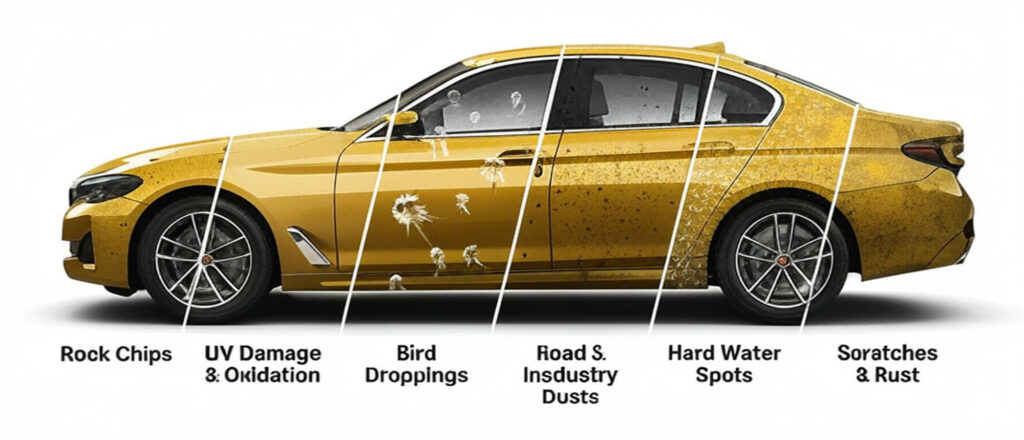Car owners are often concerned about scratches, fading paint, and resale value. Paint Protection Film (PPF) is a solution that has gained considerable traction, but whether it is worth it or not is fodder for this blog. This write-up will discuss the benefits and ppf cost, and its best-suited application, with relevant data and user experience to support your decision-making.
What Is Paint Protection Film?
Installing a transparent layer of thermoplastic urethane on a car’s painted surfaces provides paint protection. It is durable, self-healing (wherein minor scratches can just disappear when subjected to heat), UV-resistant, and impact-protective. Usually, it covers high-risk areas like bumpers, hoods, fenders, and mirrors, or an entire car.
What Are the Benefits of PPF?
PPF for cars protects against stone chips, light scratches, bird poop, bugs, tree sap, the sun’s rays, and road debris. A study in 2024 noted a 70% decrease in damage from road debris on cars protected by PPF. This saves the paint, improves resale by between 10% and 15% (according to Kelley Blue Book), and prevents damages worth $1,000-$5,000 in repainting. Quality films, such as XPEL, tend to be invisible and self-healing. John, an owner of a BMW, wrote the following on X: “Three years with PPF—my paint’s still showroom-new despite gravel hits.”

Paint Protection Film Pricing
Pricing for PPF ranges from $500 to $1,500 for bumpers, $1,500 to $2,500 for full fronts (bumper, hood, fenders), and $3,000 to $6,000+ for full cars. The price may vary depending on the size of the car, brand (3M, XPEL, etc.), and the skill level of the installer ($50 to $150 per hour). High-quality films may offer warranty coverage for 5 to 10 years, while the average cost of a full wrap for a Tesla Model 3 is $5,000.
Who Should Consider PPF?
Here are some clear considerations for Should I Get PPF for My Car:
- Luxury car owners: High-value cars like BMWs or Ferraris need pristine paint to maintain their premium appeal and resale value, which PPF guarantees.
- Frequent highway drivers: Highways expose cars to gravel and debris, while PPF prevents costly chip repairs.
- Those simply plan to keep their cars for a long time (5+ years). Keeping the paint flawless over the years is chatoyant in terms of resale value and minimizing repainting costs.
- Those in harsh environments: Sun, dust, or gravel roads all speed up paint damage; PPF assures reinforcement.
According to a 2023 survey by Cox Automotive, 60% of luxury buyers consider PPF because of these benefits.
Who can ignore Paint Protection Film?
Those owners who act on a budget, those with older or low-value cars, short-term owners, or drivers parking indoors may not have a need for PPF since waxing may often do. If you’re not concerned about maintaining a flawless paint finish or are driving an older car with a lower value
Conclusion
High-value cars, frequent drivers, and those in harsh conditions benefit from investing in PPF for car protection. Waxing or other alternatives will suffice for older cars or those with tight budgets. Owners who want long-term protection should consider this a worthwhile investment.
Frequently Asked Questions
Q. 1 ) Will it damage the paint during removal?
Professionals can remove top-quality PPF sourced from brands like UC Paint Protection Film without injuring the paint.
Q. 1 ) How long do they last?
The life span typically is 5-10 years, depending upon the type of film, its maintenance, and the conditions of driving.
Q. 2 ) Is it visible?
High-end films are almost invisible as they melt into the paint surface of the car.
Q. 3 ) Can it be done at a later stage once the car is in running condition?
You may need to correct scratches or swirls before applying paint protection film, which can increase the cost to $300-$400.
Q. 4 ) Is it better than just normal waxing?
PPF provides better protection against chips and scratches, while waxing primarily enhances shine and offers temporary UV resistance to the paint. For complete protection, some people combine both techniques.
